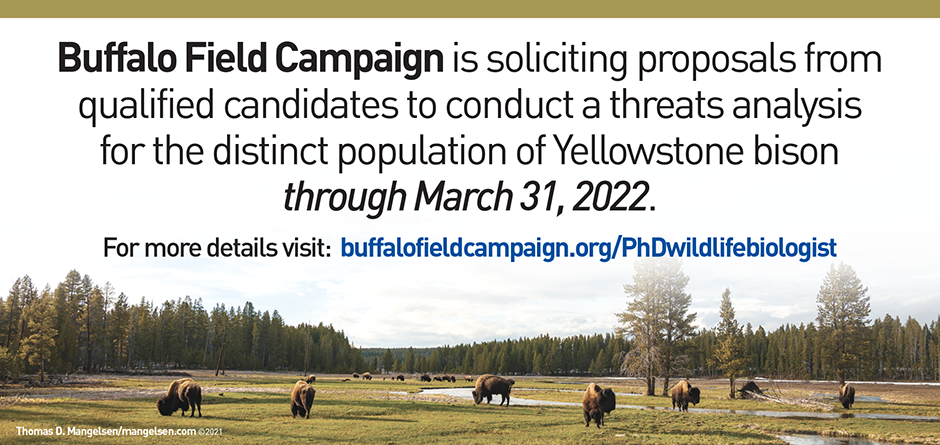Buffalo Field Campaign is soliciting proposals from qualified candidates to conduct a threats analysis for the distinct population of Yellowstone bison.
Proposals are being accepted to produce an analysis of the migratory species’ ability to self-sustain a wild bison population with distinct breeding herds in the Yellowstone ecosystem.
A qualified candidate is a PhD wildlife biologist or a PhD candidate in a wildlife biology program.
The threats analysis is a critical review of adverse factors operating on the distinct population of Yellowstone bison, and a forecast on the ability of the migratory species to naturally adapt in the wild as a viable, self-sustaining population.
The threats analysis will also consider factors increasing the risk of extinction for Yellowstone bison in the wild including significant loss of territory, population isolation, loss of migration corridors and connectivity to habitat, use of livestock and veterinary practices (domestication), the absence of State conservation measures, ineffective federal management actions, and rapid climate change.
Candidates can submit queries and Curriculum Vitae to: Angela De Sapio,
Preference will be given to qualified candidates who can compete for, and leverage, additional funding for developing the threats analysis for Yellowstone bison.
Preference will also be given to qualified candidates who have:
- performed threats analyses for wildlife species,
- experience studying American bison,
- special expertise and/or traditional knowledge of American bison, and
- knowledge of the biological principles of representation, redundancy, and resiliency.
Shaffer and Stein broadly define the principles as “saving some of everything,” and “saving enough to last.” In their application to bison:
Representation is saving populations “in an array of different environments,” and “the ecological and evolutionary patterns and processes” that allow for natural selection, adaptation and reproduction in the wild.
Redundancy is the ability to withstand catastrophic events by “having essential backups” elsewhere “as a hedge against the failure of any individual population” in the wild.
Resiliency is the ability to withstand disturbances and adverse events in protected habitats large enough to accommodate population dispersal and recovery in the wild.
Mark L. Shaffer & Bruce A. Stein, Safeguarding our Precious Heritage, (2000).
Help us spread the word: download, print, & post our ad on billboards and list serves at your University, Tribal College, Wildlife Biology program,Wildlife Society meeting, and student center meeting place. (BFC Wildlife Biologist PhD flyer 2.9 MB).
Buffalo Field Campaign is a 501(c)(3) nonprofit organization. For more information about our endangered species work visit: buffalofieldcampaign.org/endangered-bison-endangered-migration.
Buffalo Field Campaign
PO Box 957, West Yellowstone, Montana 59758 • (406) 646-0070

